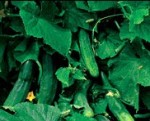 Originally native to south Asia, cucumber has been cultivated for at least 3,000 years. It is an annual creeping vine with hairy stems carrying hairy triangular leaves on long petioles. The leaves are 3-6″ long, deeply wrinkled, and have serrated margins. Male and female flowers appear on the same plant, the male flowers earlier than the females. The star-shaped flowers are 1″ across and have 4-5 fused yellow petals. The long cylindrical fruit is botanically known as a pepo and is characterized by a tough rind with many seeds scattered through the flesh. Young cucumbers are sometimes prickly but smoother as they mature.
Originally native to south Asia, cucumber has been cultivated for at least 3,000 years. It is an annual creeping vine with hairy stems carrying hairy triangular leaves on long petioles. The leaves are 3-6″ long, deeply wrinkled, and have serrated margins. Male and female flowers appear on the same plant, the male flowers earlier than the females. The star-shaped flowers are 1″ across and have 4-5 fused yellow petals. The long cylindrical fruit is botanically known as a pepo and is characterized by a tough rind with many seeds scattered through the flesh. Young cucumbers are sometimes prickly but smoother as they mature.
Cucumbers were grown in abundance in the Nile Delta and eaten raw as a salad. Because it is 95% water, the cucumber was especially refreshing in the hot climate.
Numbers 11:5 As the Israelites wandered in the desert they complained about the lack of foods that they had eaten when living in Egypt.
“We remember the fish which we used to eat free in Egypt, the cucumbers and the melons and the leeks and the onions and the garlic,”
Isaiah 1:8 The prophet speaks about the impending day of Judgment at the hand of the Chaldeans.
The daughter of Zion is left like a shelter in a vineyard,
Like a watchman’s hut in a cucumber field, like a besieged city.
Jer 10:5 (NIV)God exposes the worthless of idols.
“Like a scarecrow in a cucumber field, their idols cannot speak; they must be carried because they cannot walk. Do not fear them; they can do no harm nor can they do any good.'”
Cucumber plants need full sun, and fertile, moist, well-drained soil. Plants are generally healthy but are susceptible to macterial cucumber wilt, cucumber mosaic virus, powdery mildew, downy mildew, scab, angular leaf spot and anthracnose. Propagation is by seed.
The genus name, Cucumis, is the ancient Latin name for the plant. The specific epithet, sativus, is the Latin word meaning sativus that is sown and refers to the fact that the plant is cultivated.